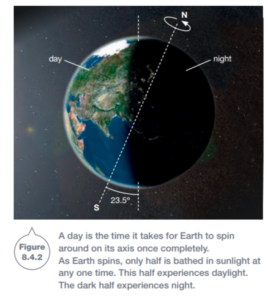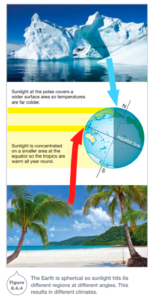Earth’s atmosphere and distance from the Sun give it the perfect conditions for life, allowing it to sustain millions of different species on its surface and under its seas. Earth rotates on its own axis and revolves around the Sun, making the Sun, the Moon and stars appear to rise in the east and set in the west.
The Earth in space
- Every day the Sun appears to rise in the east and set in the west, as do the Moon and stars.
Day and night
- An imaginary line called the axis runs through the Earth from the North Pole to the South Pole
- Earth rotates(spins) around this axis
- The time taken for any planet to rotate around its axis is a DAY
- Earth takes 24 hours to complete one rotation, and so one day on earth is 24 hours.

The year
- A year refers to a planet taking a full revolution around its star
- For earth, the year is 365.25 days
- We do not count the extra quarter day each year but add an extra day every 4 years
- If a year is divisible by 4 it is a leap year

Climate
- Different parts of the earth experience different temperatures
- The equator experiences the most sunlight year-round so it experiences the hottest climate
- Areas around the equator are known as the tropics
- The north and south pole experiences the least of the suns rays and so experiences the coldest climate

Seasons

https://create.kahoot.it/share/year-7-space-quiz/bdf1c70c-ceb8-4e2d-9247-2902a1d77993




